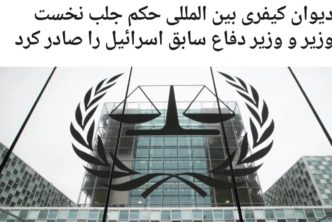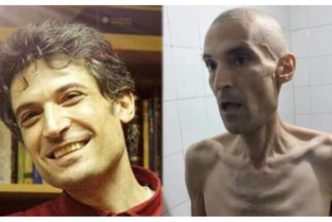This article has been send to The 2nd World Congress Against the Death Penalty, jointly organized by ECPM (Ensemble Contre la Peine de Mort / Together against the Death Penalty) and PRI (Penal Reform International) be held in Montreal, Canada, from October 6 to 9, 2004
Consequently of the prevention of writer to exit Iran, the article has been presented to the conference .
It is impossible to present precise figures of issued and performed death penalties in Iran owing to the fact that the judiciary system considers these figures to be confidential. In this respect, as there is no formal and accurate data, the speculations made in this regard are controversial, some close to reality and some unconvincing.
It is impossible to present precise figures of issued and performed death penalties in Iran owing to the fact that the judiciary system considers these figures to be confidential. In this respect, as there is no formal and accurate data, the speculations made in this regard are controversial, some close to reality and some unconvincing.
In its report on human rights condition in Iran in2002, the Amnesty international stated that 113 people, including 6 women, were sentenced to death. Abdul-Karim Lahiji, the head of ‘The League for the Defence of Human Rights in Iran’ announced on 21.03.2003 that in the previous year there had been 475 death penalty cases in Iran. David Patrick Paul Alton a cross bench member of the House of Lords said on 10.11.2003, “according to the reports by Iranian officials, in the current year 292 people have been executed, which is already double the number announced last year”.
The Austrian newspaper Der Kurier on 19.09.2002 wrote that 274 people have been executed in Iran in that year.
Nessuno Tocchi Caino (Hands off Cain), the Italian organization campaigning against the death penalty in the world, announced that during 2001, at least 4,700 people were executed in 34 countries. The first three countries in this list were; 1. China with at least 3,500 cases, 2. Iran with at least 198 cases, including at least 6 women and 1 juvenile, and 3. Iraq with at least 179 cases.
In its announcement on 21.01.2004, the Amnesty International indicated that since the year 2002, 113 people were executed in Iran. Meanwhile the British Secretary of State for Foreign and Commonwealth Affairs stated in a report (dated 18.09.2003) that in the year 2002, 111 people were executed in Iran. Nessuno Tocchi Caino (Hands off Cain) in its report on executions worldwide puts Iran, with at least 316 cases, in the list after China. Iraq with at least 214 cases and the US with 71 cases are next in the list. According to this report at least 4,078 executions were carried out in 34 states in the year 2002.
For the year 2003 miscellaneous figures were published. The Amnesty International proclaimed that in 2003, 108 people were executed. The Iranian human rights activists in Europe and America stated the same number in their letter to the European Union. Nessuno Tocchi Caino (Hands off Cain) reported that 154 cases of execution were reported from Iran which shows a sharp decline in comparison with the number of the cases, reportedly at least 316 cases, in the previous year.
Considering the execution of juveniles, the Amnesty International reported on 30.01.2004 that since 1990, 34 cases of executions of the youths were carried out in the world, 7 of whom were reported from Iran.
Reality; the Minimum Number
As mentioned earlier there is diversity in the numbers of executions carried out in Iran, and all these figures differ from the numbers the Iranian officials have declared. An illustrative example is the report published by Sunday Telegraph in October 2002 stating that in that year 292 people were executed in the country, following this report the Islamic Human Rights Commission in Iran send a letter to the Prisons Guardian Organization inquiring the exact number of execution. In response to this request the organization declared that the total number of the executions were 59 cases which were carried out for the charges like wilful murder, armed robbery, iniquity, kidnapping, rape and drug trafficking, all of which were carried out in the public.
Following all the vain attempts to reach official sources for the actual number of executions, I went through all the newspapers from 21.03.2001 (the beginning of Iranian calendar) onwards and composed the data in the following table. Considering the fact that all the news about executions never get published in the press, one can assume that the actual number is slightly higher than the ones stated here and that these numbers are the minimum.
The minimum number of executions (based on the news published in the press)
March 2001- September 2004٭click here
click here
Two Hypotheses
There are two basic hypotheses in this brief investigation;
1. Those sentenced to death are as old as the Islamic republic,
2. Those sentenced to death are mainly from a lower class of the society.
The data of this investigation, which can be found in the supplemented tables, approve these hypotheses. However the main question is why this is so.
The first hypothesis is that those sentenced to death were either born after the 1979 revolution or most of them were brought up during the time of the theological state. In a theological state there are more claims for morality and spirituality, nevertheless the abovementioned statistics are contradictory to these claims; on one hand there is the violent nature of death penalty, and on the other hand they indicate that despite severe social control and in spite of religious publicity, the rate of delinquencies and felonies remains high which in turn lead to high rate in death penalty.
In response to this problematic I would briefly mention certain points:
1. There is a direct relation between the validity of moral values and the theological state. In a society where religion is the origin of moral values, due to the linkage between religion, clerics and ethics, as the validity and viability of the clerics decline one can witness the weakening of peoples’ religious beliefs. As a result of this the morals are disregarded owing to the fact that the clerics are regarded as the representative of the religion, they are the ones who preach and narrate morals and ethics. Therefore any discontents and mismanagements of the affairs under the reign of clerics, declines the moral authority and validity of the clerics.
2. Formal and normative values publicised by the power structure are received dubiously by the public.
3. The abovementioned findings indicate that as the Emil Durkheim, the French social theorist, defines society has a reality and objectivity autonomous of the will and intention of individual and states, following its inner mechanism, and that the state is only one, and not all, of its effective variables.
4. Part of the committed crimes is due to the decline of values and part of it is reactions to the state.
5. The rise in the figure executions and offences in Iran is due to the fact that in the Islamic Republic of Iran those misdemeanours like carrying and selling narcotics, which are not regarded as crimes and major offences in other parts of the world, are classified, according to the penal laws, as felony and execution is designated as its punishment.
The second hypothesis: by investigating the social status and the biography of those sentenced to death, it can be seen that the majority of these people are o be stratified as the lower class of the social hierarchy. Is this supposed to mean that that there are no crimes committed among those in the upper class? Why all or the majority of those sentenced to death are categorised as belonging to the lower class (in educational and financial aspects)? Ironically preliminary investigation on those convicted to death in poor or rich, democratic or undemocratic countries largely indicated that this trend is almost common everywhere.
Of course this does not mean that there is no crime committed in the upper classes of a society or those belonging to lower classes have more tendency to commit crimes but:
1. due to having access to financial, cultural resources and better opportunities to take advantage of, there are more chances for the upper class to conceal the traces of the committed crimes,
2. in the upper classes the crimes are not seen or might get justified so not all the wrongdoings are revealed, as the saying goes the grass is always greener on the other side of the fence,
3. crimes in upper classes rarely get revealed and the news are faded by the status privileges.
There is another factor worth considering in this regard which is well beyond the violent aspects of the committed crimes and the feelings they might cause, namely the socio-cultural factor. There seems to be an explicit relation between poverty, financial and cultural deprivation, and the figure of crimes and death penalties. Those who commit crimes are largely victims and the result of economic and cultural deficiencies.
While crime-committing is a common phenomena and can be found in different forms and levels among all the social classes and cannot be labelled to a specific social stratum, people sentenced to death are to a large extent classified as belonging to certain social class. This itself provides and illuminative example for disapproving death penalty. A case study of every offender would cast light on how judgement and passing verdict about the life and death of an individual can turn up to be biased and one-sided. Referring to two cases that in recent years which has drawn popular attention in recent years in Iran can set a shining example in this regard. The “Night’s Bat” was a criminal in disguise of a taxi gave lifts to young women in the street of Tehran, a job quite common to those who do not earn enough money to run their living. He would subsequently rob the women and kill them. Or an eighteen-year old youth in the southern deprived districts of Tehran who used to kidnap children, kill them by hitting them in the head and throw them in water wells. By the look of it the public would suggest that sentencing these criminals to death would be a fair punishment, however scrutinising the cases would reveal other aspects of the crimes mainly related to social, economic and cultural positions of these people and would also rise the question that why they are more exposed to violently victimise and become victims.
The Difficult Task of Adjudication
Passing judgment on the death penalty is utterly complicated due to legal and emotional burden it implies. When situated in a crime scene and the cruelty of a murderer is envisaged, one might excitedly and irritatedly deduct that for a woman who collaborated with a stranger and stabbed her husband to death, or a man who slaughtered his wife, or a drug-addict who killed a little girl to take her bracelet, the only fair punishment is execution as they all deserve death and are not eligible to stay alive.
If these incidents are seen in one picture strip together with the scenes related to the corporal punishments in another strip simultaneously, the image would be humans killing each other savagely. The killer in the first strip would become the victim in the second. Violence is responded with violence causing a vicious circle that would result in endless killing of human beings.
The Cultural Aspect of Violence
One of the figures in the above table is related to domestic violence and murder. Those who committed these murders were sentenced to death, however, this question can be put forward whether execution and death sentence could justify these killings or not.
When a crime is occurred, everybody is looking for the criminal and the agent of the crime, then ‘an individual’ is found and charges are brought up against him, that ‘individual’ is put on trial; everyone looks at this case individualistically. Nevertheless, this incident has its own cultural and sociological aspects.
In a society that violence is publicised and is normative deciding on killing others is facile and simple, even if the murderer is well-aware of the consequences. This is mainly due to the fact that institutional norms are easily surfaced at the times of excitement. Apparently the criminal act might appear to be self-conscious but the person committing the crime is driven to it unconsciously. Organised crimes have their own origins of stimulations, in political assassinations there are ideological backgrounds, the agent(s) grow a hatred feeling towards the victim, which is only satisfied when the victim is killed. In all these cases, violence increasingly becomes routine and an acceptable norm. Therefore a religious, moral and divine justification is created to disguise the crime. Even those killing their spouses in domestic violence and murder, are able to create religiously and morally justification and accuse them of having illegitimate affairs, as they believe this is quite acceptable.
A Sociological Outlook
The murders in the table above are also significant from a sociological perspective. The reality in all these cases are contradictory to the imagination of all the people engaged (whether the murderer, the victim, or the observers), and the investigators as they all label these conducts and represent them as individualistic problems whereas they are social stresses and pressures conveyed to the individuals. The figures related with murders and homicide has a complete correlation with social, economic and political pressures. In the first 2-3 years after the 1979 revolution the rate of crimes decreased significantly as there was hope and everyone felt that they could be actively involved in their future, but soon after that there was a drastic increase in the number of crimes and violent acts, again in the short period of reformist movement in 1997-200 there was a decrease in the rate of crimes and violence but after these early years we yet again witness an increase in these rates.
Therefore, what apparently appears to be private and individual affair caused by marriage and family problems, is in reality a reflection of the social environment.
The increase in murders and homicides are the result of Anomie, a state of “normlessness” or “rootlessness” created by the breakdown of common standards of behaviour and morality. This could explain the deviance and crime as a result of disparity between high goals and limited opportunities.
On other aspect which shows the link between political affairs on one side and murder, malfeasance and anomie is social and political disenchantment. In modern societies people impose their will and power through voting and in civil ways. This voting and civil ways of expressing one’s opinion would avoid any feelings of humiliation and degradation among the general public. Furthermore when the public is not able to show its power or votes for a person who is deprived of his power to carry on the reforms promised to the public, people would feel disgraced and mortified. Once the society comes to believe that peaceful ways of reforms are impeded and cannot find a way to resist against the dominant repressing power a deep feeling of disenchantment emerges. Ordinary people might not realise the actual source of individual violence, murder, suicide and divorce, however looking at the problem from a social psychological standpoint the consequences of social disenchantment is well reflected in personal conducts. Today the socio-political disenchantment has reached a considerably high level and therefore one may conclude that the rise in violent crimes is to a certain extent the outcome of such feeling. When a person feels somehow hopeless in changing the macro social processes and structures, might try to take revenge of other people, whether of those who are complete strangers or those who are in the intimate circle of family and relatives.
It seems that we are apparently dealing with four circumstances:
1. an increase in the normative and value contradictions in a way that it is reaching a turning point,
2. this has generalised the extent of contradictions and chaos,
3. the anomic situation and abnormity is not hidden any more and has increasingly become revealed and known,
4. the disenchantments have reached its peak and caused subsequent reactions.
These circumstances have caused the followings;
1. the increase of violence and murder in the youths who are brought up and educated during the reign of Islamic republic,
2. an increase in family killing and murdering to restore honour (killing women who allegedly been accused of adultery),
3. an increase in death penalty and more violent crimes,
No problem can be solved with death penalty; it would make the matters more complicated. We believe that social and cultural reforms are the appropriate response to the abovementioned problems.
Reviewing the experiences and histories in the last two centuries reveals that there has been no decrease in the rate of crimes because of imprisonment and death sentence. Allegorically it can be said that where slough is found no one can escape the torment of flies and insects you may choose the way of killing them all but there as long as the slough exists the agony would remain.
The problem of crimes originates from the society, no social problem can be overcome by eliminating individuals.
Mid-March 2001 – Mid- March 2002
Mid- March 2002 – Mid- March 2003
Mid- March 2003 – Mid- March 2004
Mid-March 2004- September 2004




